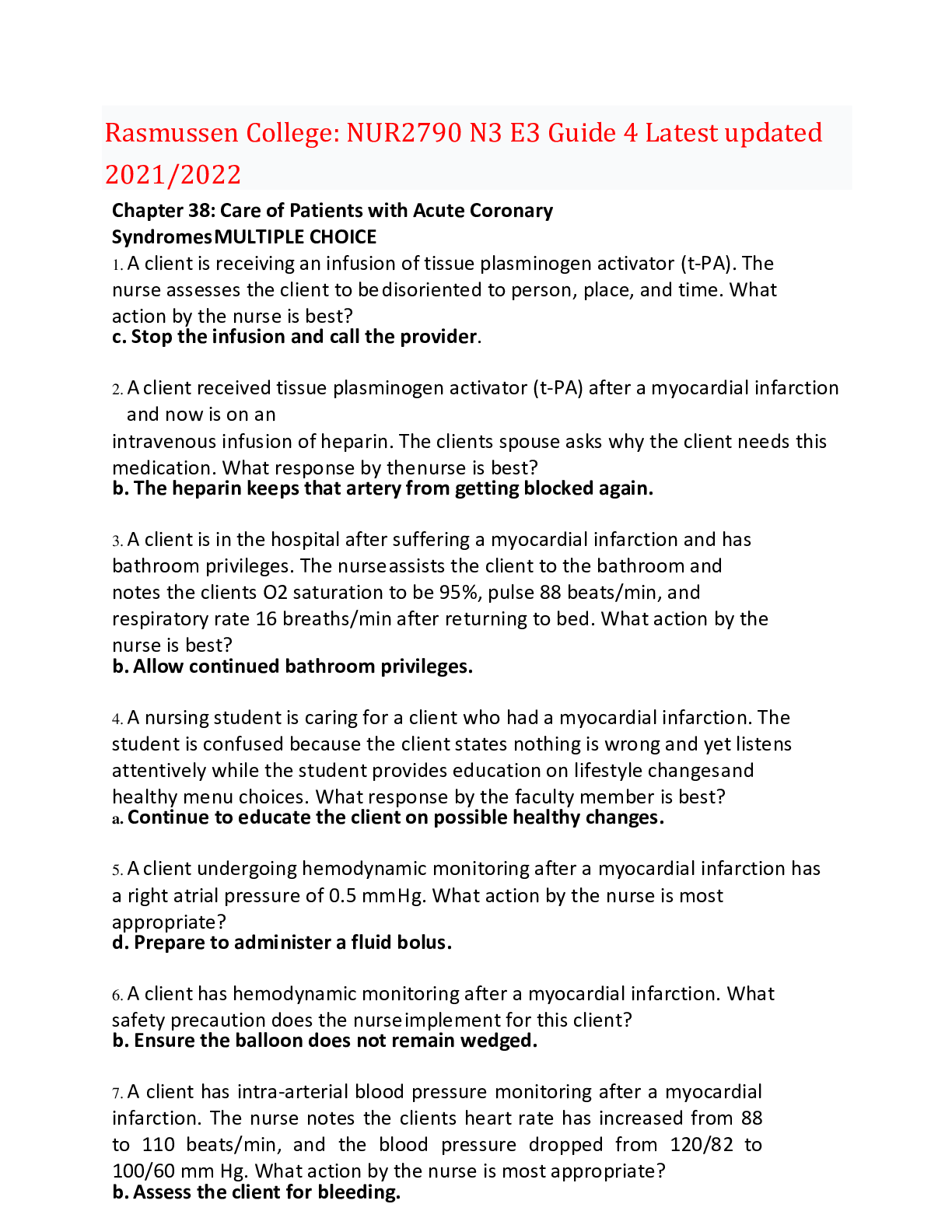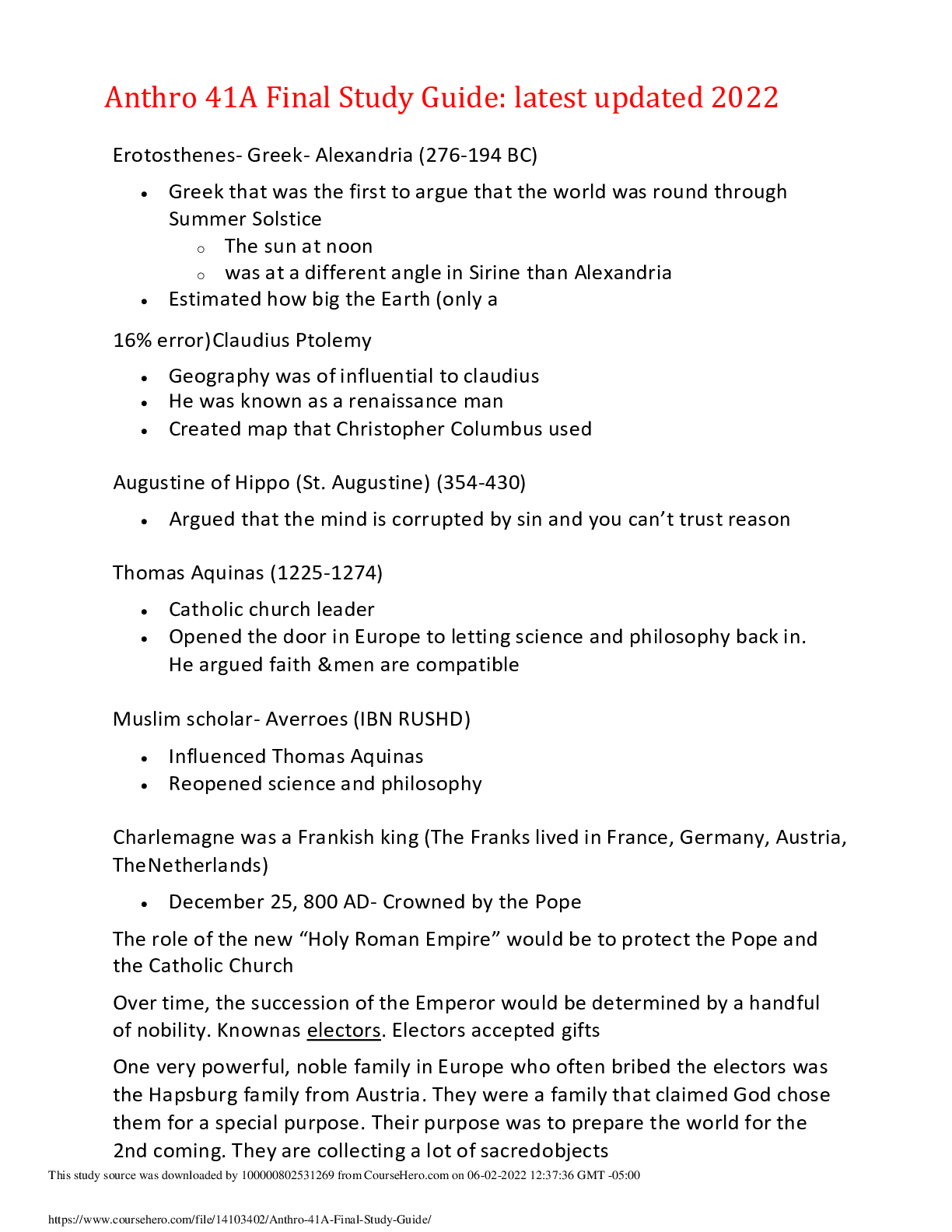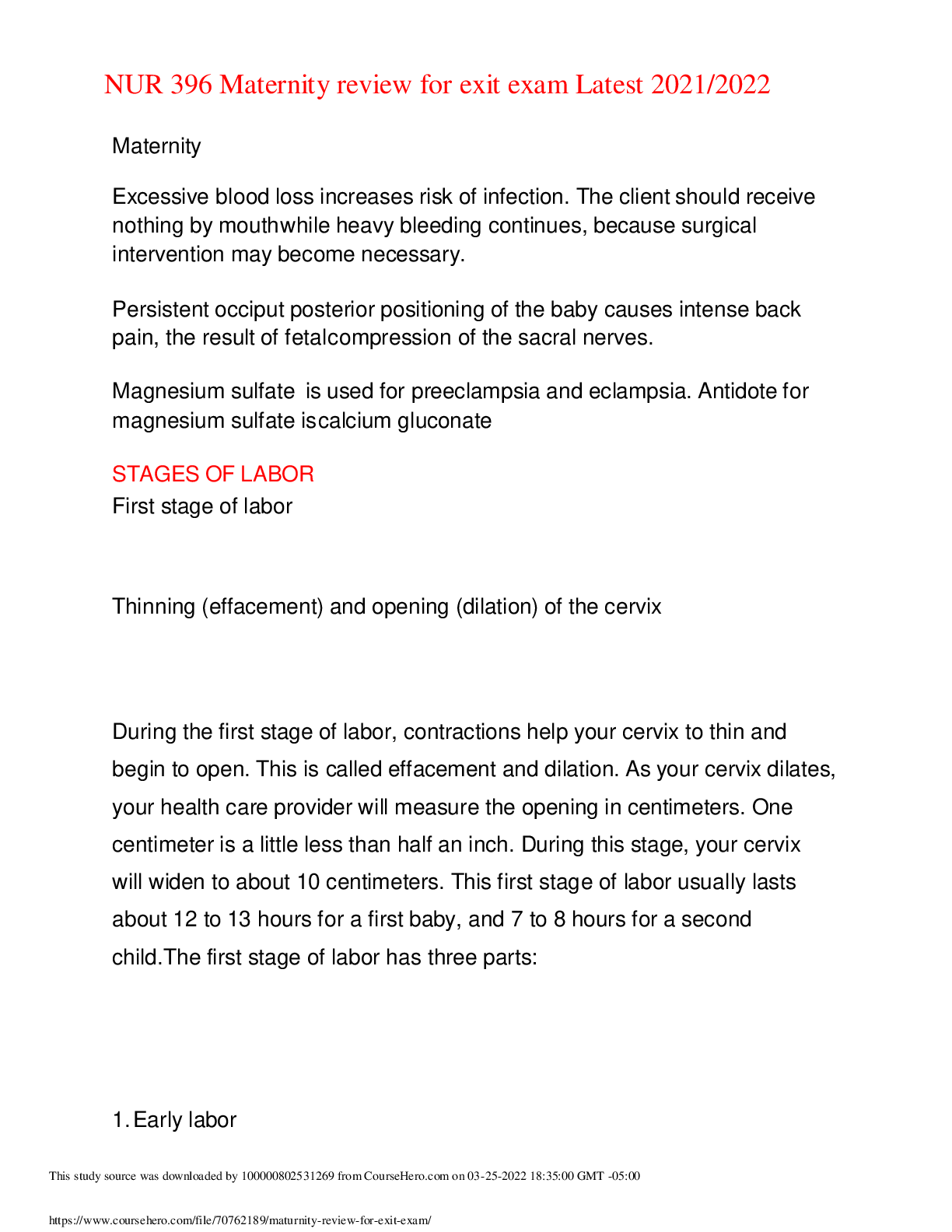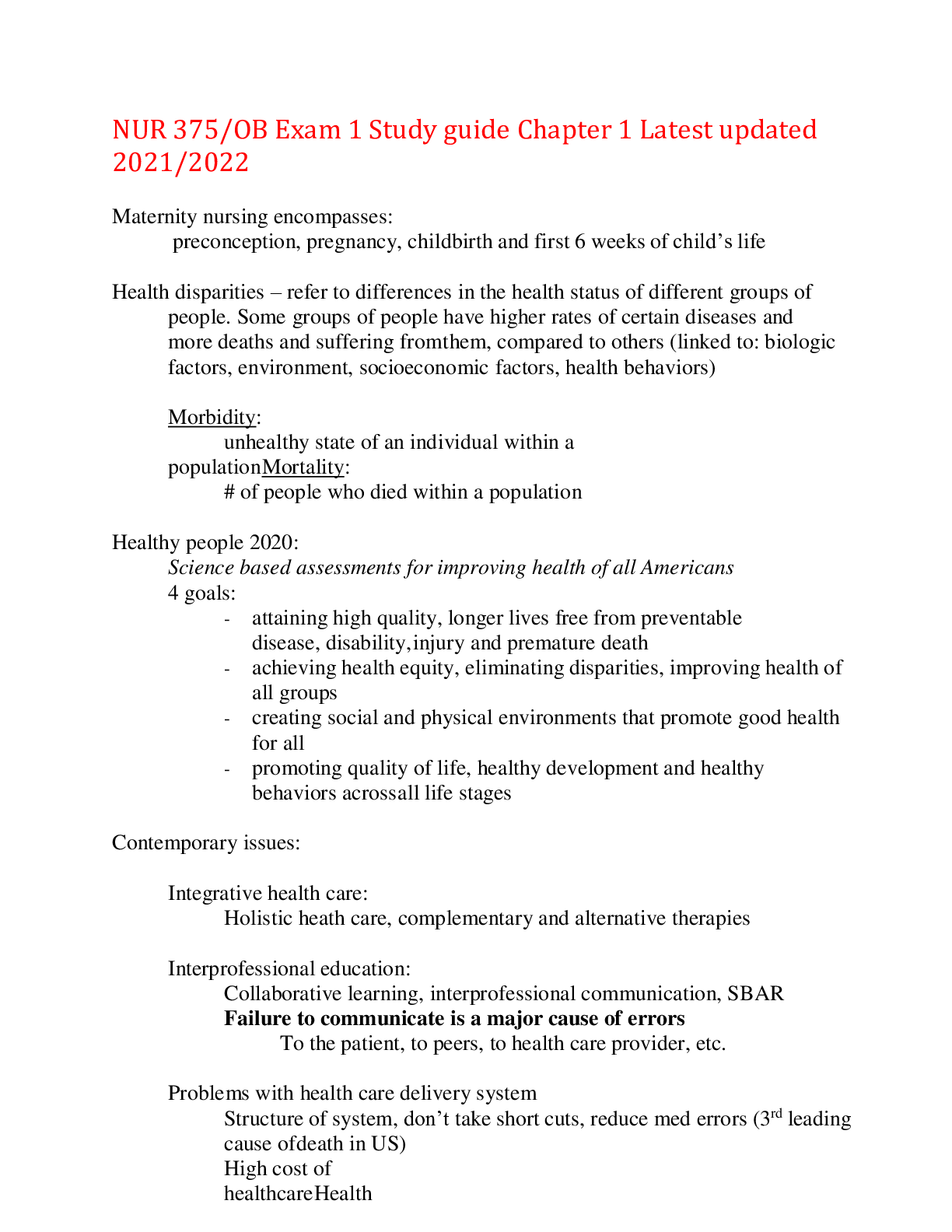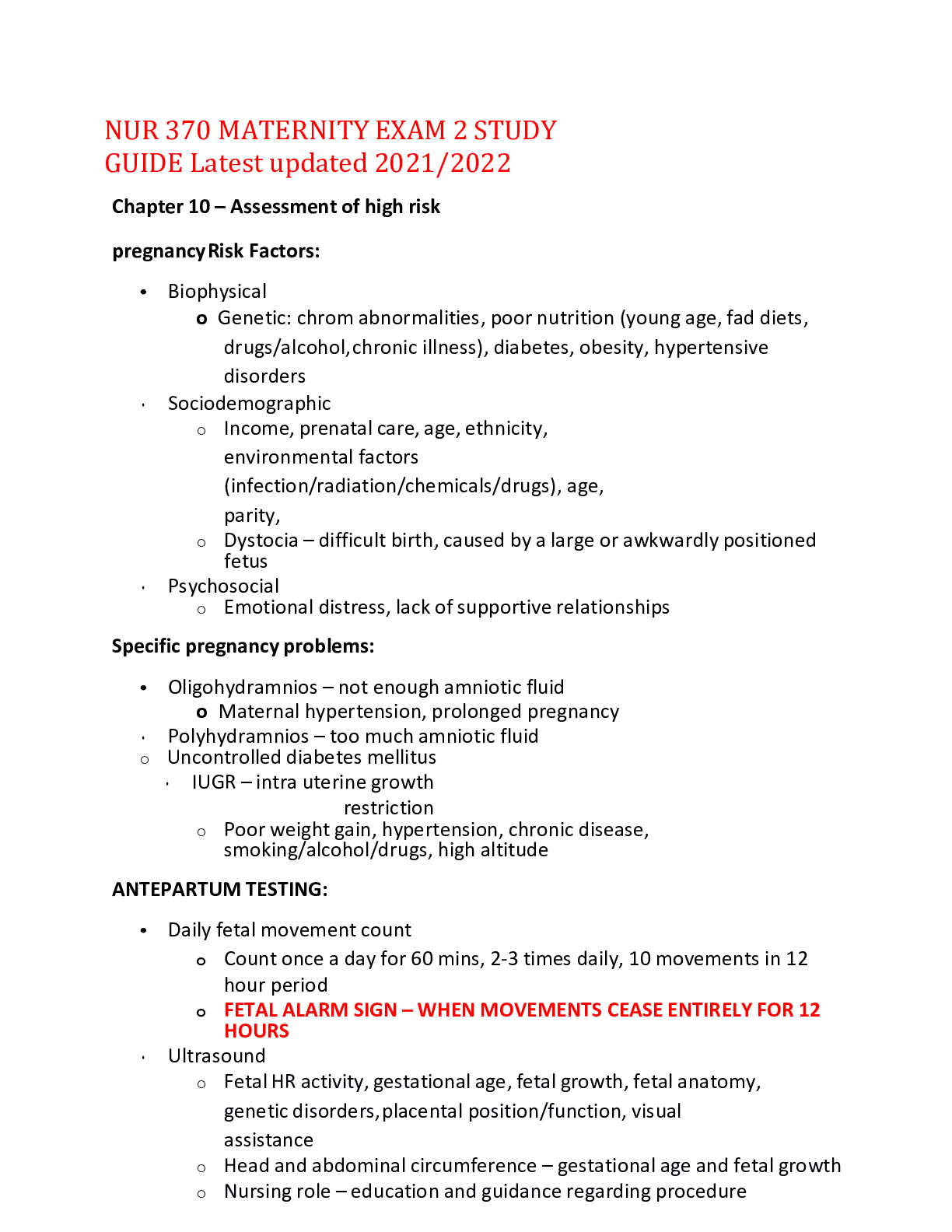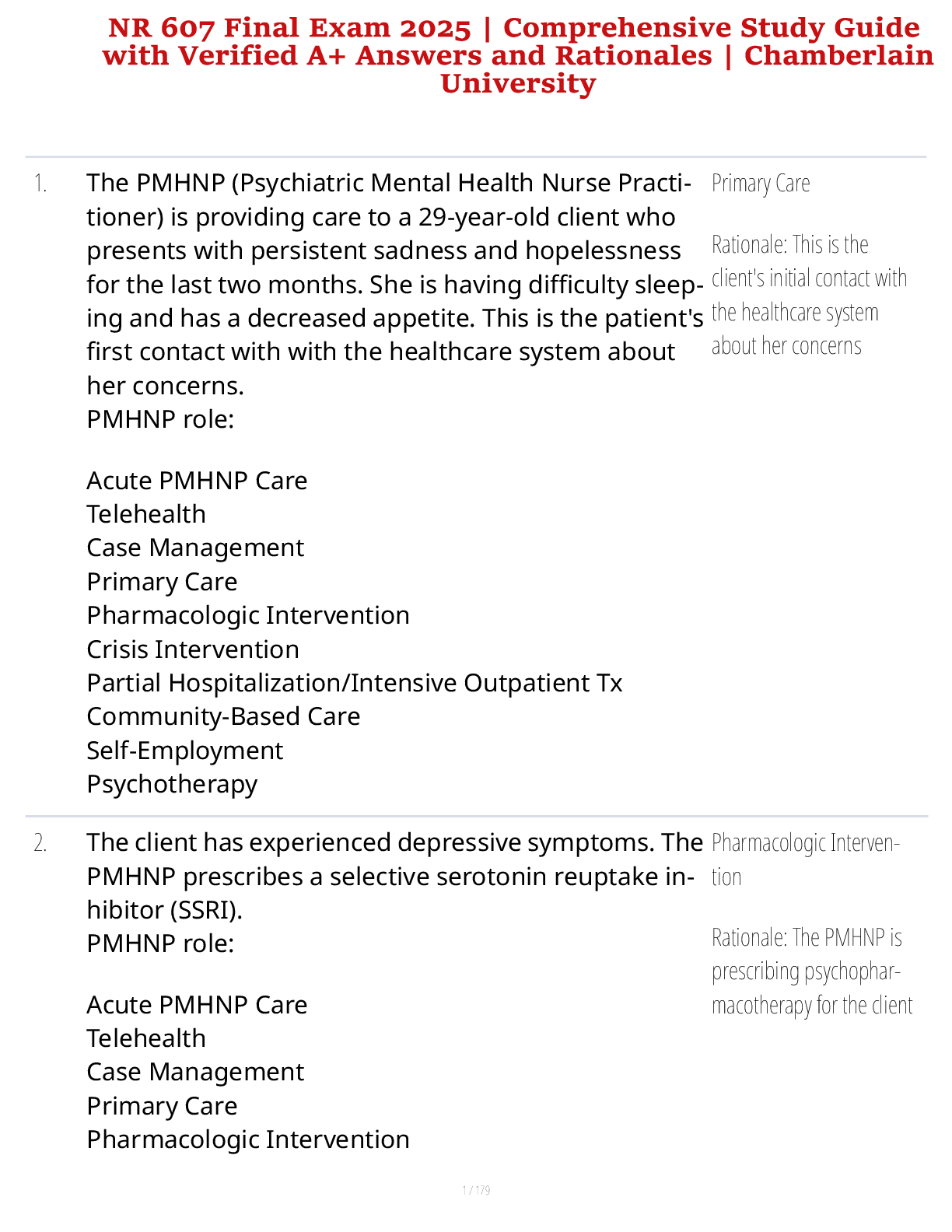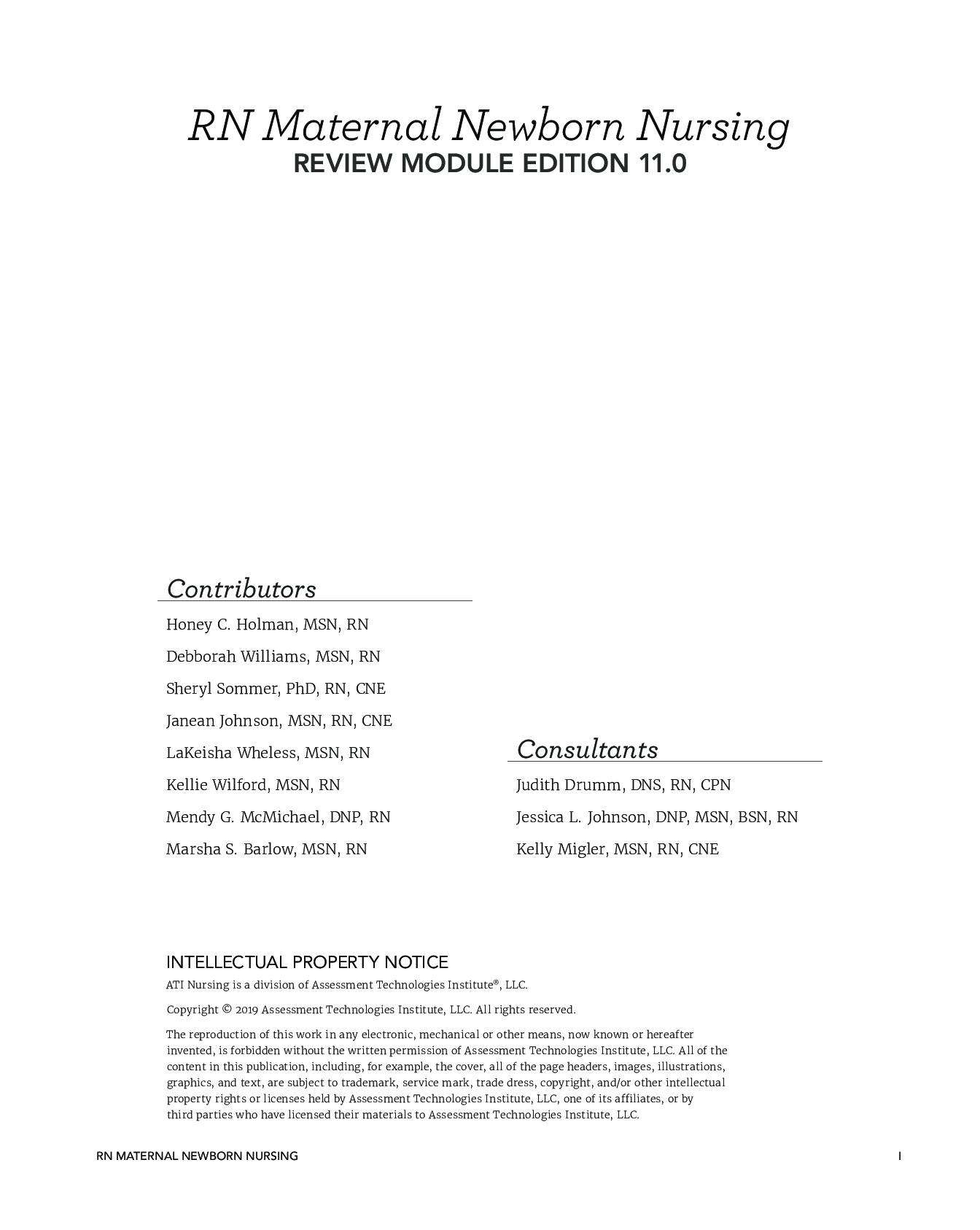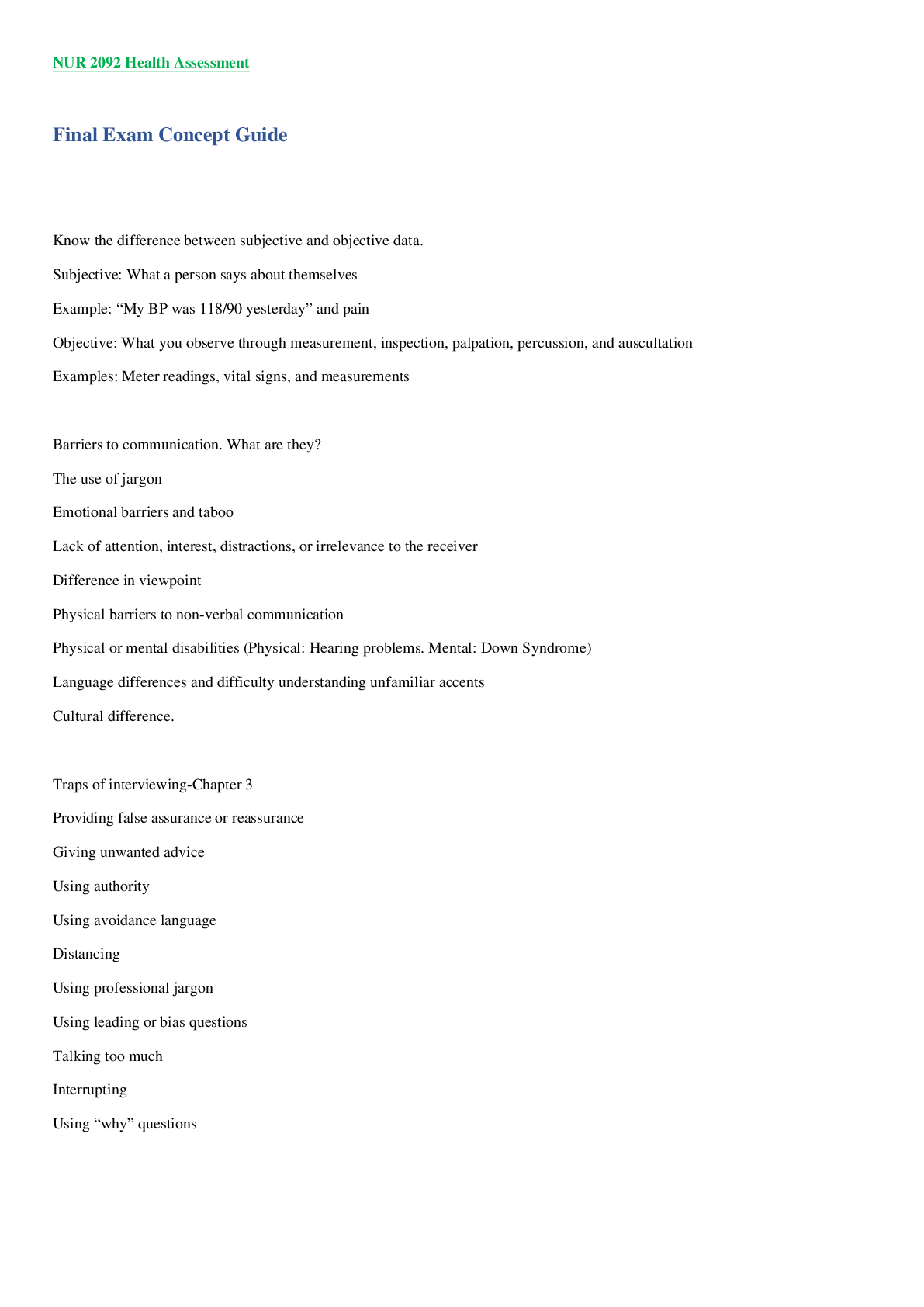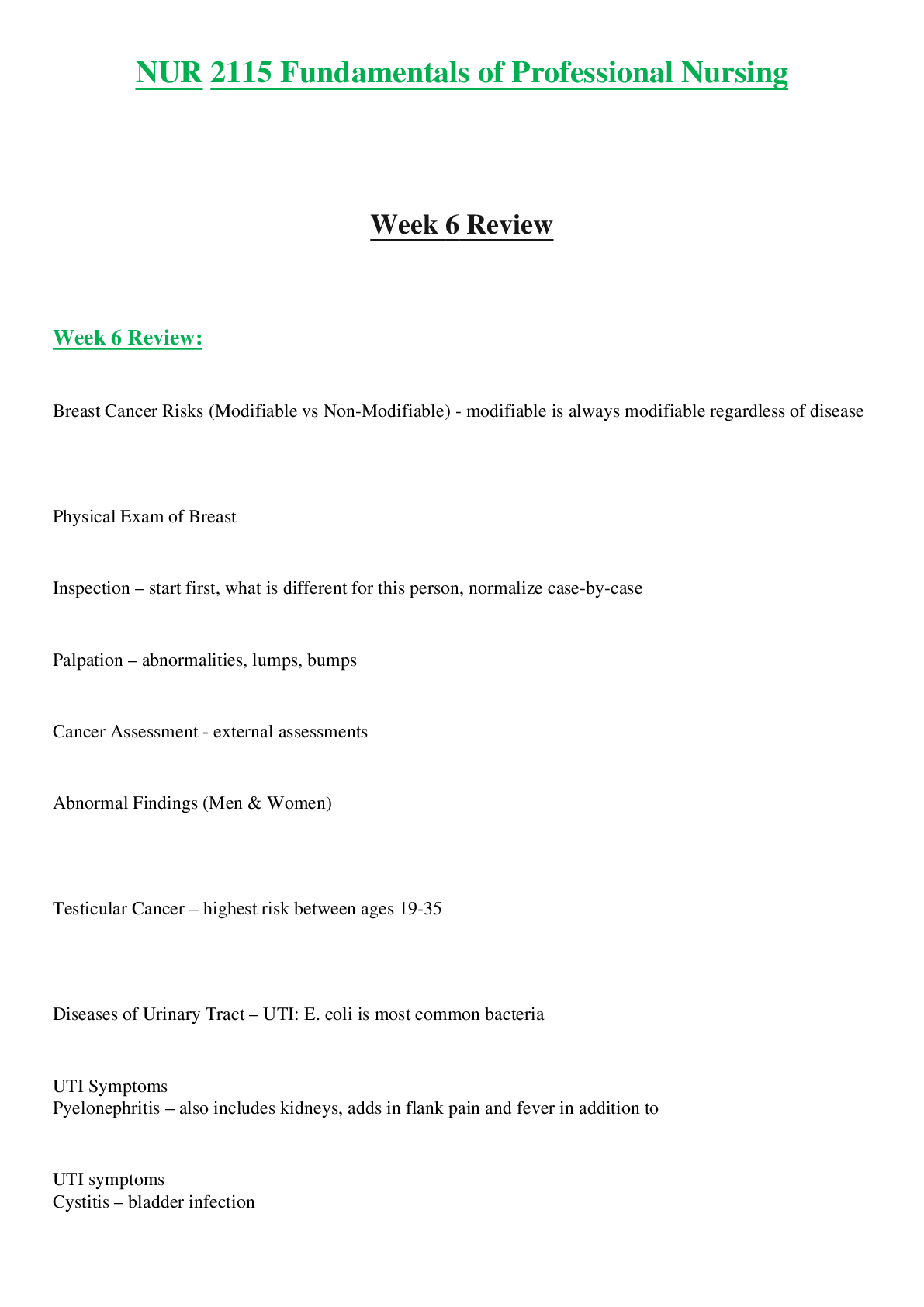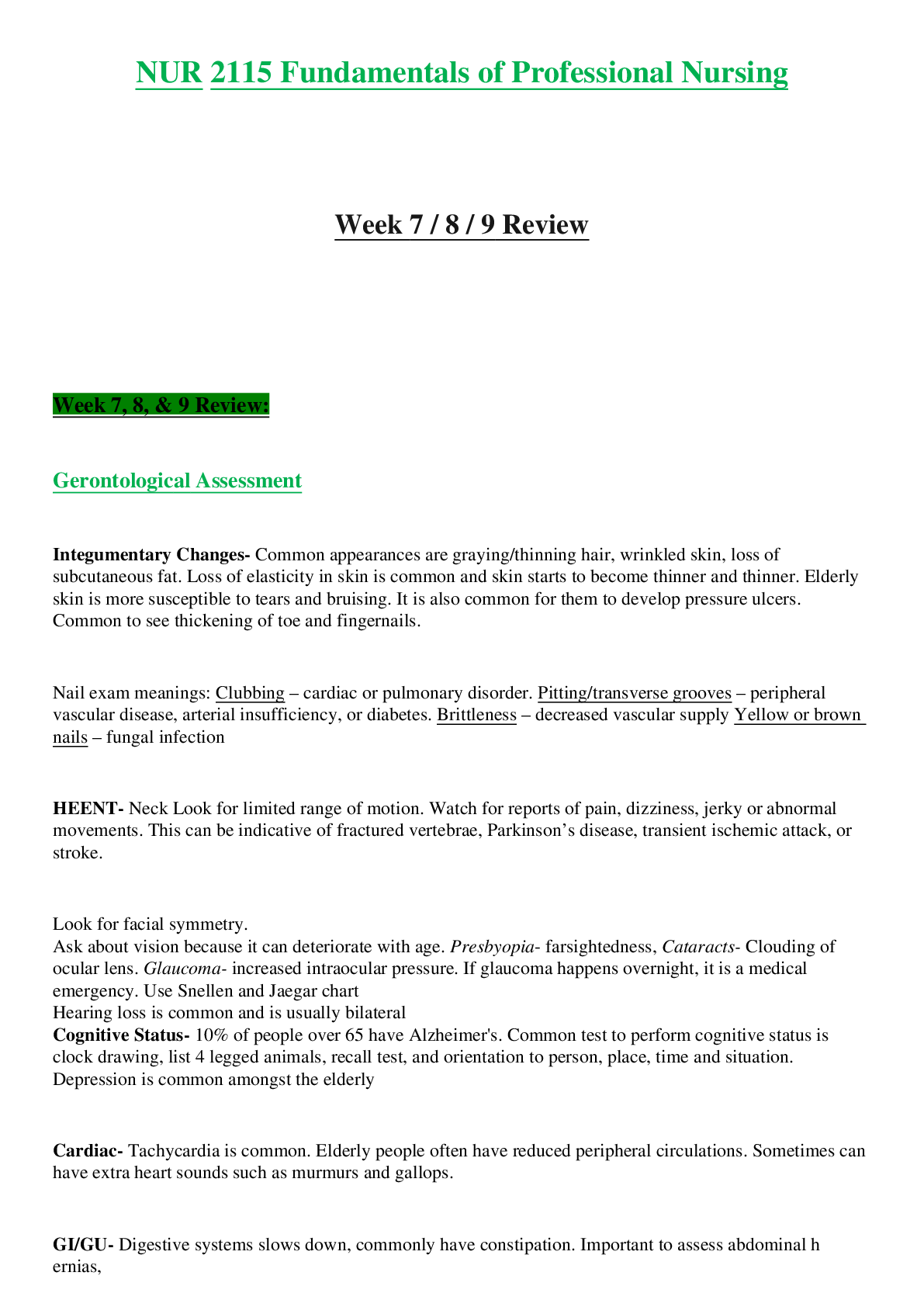*NURSING > STUDY GUIDE > NR 566_Chapter 33_completed Study Guide_ LATEST UPDATED,100% CORRECT (All)
NR 566_Chapter 33_completed Study Guide_ LATEST UPDATED,100% CORRECT
Document Content and Description Below
NR 566_Chapter 33_completed Study Guide_ LATEST UPDATED CHAPTER 33: DIABETES MELLITUS ➢ Clinical S/Sx o T1DM- abrupt, although insulin secretion decline begins long before the symptoms develop. ... ▪ Classic manifestations (new onset): • Polydipsia • Polyuria • Wt loss • Hyperglycemia • Ketonemia or ketonuria ▪ DKA = classic s/sx + fruity-smelling breath + drowsiness/lethargy + vomiting ▪ Silent (asymptomatic) incidental discovery o T2DM ▪ Polydipsia ▪ Polyuria ▪ Hyperglycemia ➢ Risk Fx and Associated complications o T1DM ▪ Genetic • abnormalities at six genetic loci • mutation of the hepatic transcription factor (HNFP-1 alpha) on chromosome 12 • defective glucokinase molecule on chromosome 7p ▪ Autoimmune- destruction of islet cells -> beta cells destruction ▪ Environmental- toxins, food antigen, viral infection ▪ Race- idiopathic T1DM is common among African American or Asian American. o T2DM ▪ Obesity ▪ Race- native americans, Asian americans, latinos, pacific islanders, african americans ▪ Sedentary lifestyle ▪ Hypertension ▪ Dyslipidemia ▪ Family hx- 15% if both parents have T2DM ▪ Gestational hx ▪ Age ▪ Genetics- have strong influence- chromosome arm 7q – insulin resistance o COMPLICATIONS (all types): ▪ Microvascular • Eyes, heart, kidneys, nervous system • Retinopathy with potential loss of vision • Nephropathy leading to renal failure • Peripheral neuropathy with risk of: o Foot ulcers o Amputation o Charcot’s joint • Autonomic neuropathy with: o GI, GU, CV s/sx o sexual dysfunction may occur. ▪ Macrovascular • Atherosclerotic conditions which increases the risk of HTN, abnormalities in lipid metabolism, abnormalities of platelet function, and periodontal disease: o Cardiovascular o Peripheral vascular o Cerebrovascular ➢ Diagnostic Criteria o Pre-diabetes ▪ BG too high to be considered normal BUT does not meet criteria for DM • Impaired glucose tolerance (IGT) or Impaired fasting glucose (IFG) • IFG 100-125 mg/dL • IGT 140-199 mg/dL • HbA1c 5.7% - 6.4% ▪ At risk for diabetes and CVDs and may have insulin-resistance syndrome o T1DM and T2DM ▪ 4 tests used: • Acute symptoms of DM + casual plasma glucose ≥ 200mg/dL • Fasting plasma glucose (FPG) >126 mg/dL- most reliable • 2-h post-load plasma glucose in an oral glucose tolerance test ≥ 200mg/dL • HbA1c ≥ 6.5% ▪ Tests should be: • confirmed on a subsequent day, unless (+) overt clinical s/sx • preferrable to confirm with the same test OR one that is considered more predictive • If a repeated test is below the diagnostic criteria -> REPEAT TEST in 3- 6months. ➢ Criteria for screening asymptomatic adults o Individuals with BMI ≥25 and: ▪ ≥45y/o- should be tested, if normal- repeat test at 3yr intervals. ▪ ≤45y/o + risk factors: • Physically inactive • First-degree relative with DM • High-risk ethnic group (African American, Hispanic, Native American, Asian American, Pacific Islander) • Delivered a baby weighing >9lbs or previously dx of GDM • Hypertension (BP ≥140/90) • HDL cholesterol ≤35 mg/dL and Triglycerides ≥250 mg/dL • (+) PCOS • IGT or IFG on previous testing • Conditions associated with insulin resistance (PCOS, acanthosis nigricans) • Hx of CVD ➢ Insulin and OHG o Insulin- exogenous insulin produces the same effect as the naturally occurring hormone. ▪ Lowers BG levels by: • Promoting protein synthesis by increasing amino acids transport into cells • Stimulates glucose entry into cells as energy source • Increases storage of glucose as glycogen (glycogenesis) in muscle and liver cells • Inhibits glucose production in liver and muscle cells (glycogenolyis) • Enhances fat storage (lipogenesis) and precent mobilization of fat for energy (lipolysis and ketogenesis) • Inhibits glucose formation form non-CHO sources, such as amino acids (gluconeogenesis) ▪ Basal insulin once or twice daily ▪ Subcutaneous injection (IV in hospital settings for rapid acting like regular insulin) ▪ 2 long-acting insulin analogs (important breakthroughs in DM management and tx. • Insulin glargine- o can be given at HS or at any time of day (but should be given consistently at the same time each day. o CANNOT BE MIXED with other insulin • Insulin detemir- o Prolonged absorption o Provides a more consistent 24-hr basal effect d/t to its protein binding effect in the plasma and near injection site o Cannot be diluted or mixed with other insulin preparations • BOTH glargine and detemir- o may have less nocturnal hypoglycemia effects o expensive than NPH ▪ T2DM will usually require insulin d/t progressive beta cell dysfunction after a period of time. • Preferred: basal insulin once or twice daily (IAI or LAI) • NPH- nocturnal hypoglycemia o Oral Agents ▪ Only effective in T2DM ▪ Monotherapy (reduction of A1c by 0.5%-2.0%), combination therapy (further decrease in A1c) ▪ PRIMARY CARE PROVIDER SHOULD COORDINATE THE START OF MEDICATIONS WITH AN OB OR ENDOCRINE SPECIALIST! ▪ Beguanides • Are not considered hypoglycemic drugs • INITIAL DRUG OF CHOICE for monotherapy • Metformin o Decreasing hepatic glucose production by decreasing gluconeogenesis o Increases peripheral glucose uptake and utilization o Improves response to blood glucose levels so that the liver produces appropriate amount of glucose o Decreases intestinal glucose absorption • Initial dose: Metformin 500mg once or twice daily (max dose 2,550mg daily) • Titrate dose to decrease GI adverse reactions • Helps with weight loss and reduction in LDL-C, reduction in total cholesterol, reduction in triglycerides, and increase HDL-C. ▪ Sulfonylureas • Increase endogenous insulin secretion by the beta cells and may improve the binding between insulin and insulin receptors or increase the number of receptors • (+) hypoglycemic effects – d/t increased endogenous insulin and improved beta cells sensitivity to BG levels or suppression of glucose release by the liver. o Risk for hypoglycemia when taken with abx (clarithromycin, levofloxacin, TMP/SMZ, metronidazole, ciprofloxacin) • Used to be the first class to treat T2DM, but now considered SECONDARY AGENTS partially d/t hypoglycemic risk. • PREGNANCY CATEGORY C (except for glyburide) • Common S/E: hypoglycemia, wt gain • 1st GENERATION- chlorpropamide, tolazamide, tolbutamide • 2nd GENERATION- glipizide, glyburide, glimepiride ▪ Alpha-Glucosidase inhibitors • Do not act directly on any of the defects in metabolism seen in T2DM • Competitively inhibit and delay absorption of complex CHO from small bowel and lower BG levels after meals. • No weight gain, does not promote wt loss • Limited role as adjunct therapy to individuals who can not take metformin (except those patients on NGT) • Can reduce A1c by 0.5%-1% ▪ Thiazolidinediones (TZD) • Oral antihyperglycemic agents best classified as “insulin sensitizers” • Activate a nuclear receptor that regulate gene transcription -> increased utilization of available insulin by the liver and muscle cells, and adipose tissue. • Reduce hepatic glucose production -> appropriate glucagon production by the liver • pioglitazone (Actos) and rosiglitazone (Avandia) • Precautions: RISK FOR CARDIOVASCULAR PROBLEMS. o Rosiglitazone- close monitoring of heart failure s/sx • Fluid retention is also a notable s/e of the drug class • Bladder Cancer- high risk for north American and European diabetics. • Reduce A1c by 1.5%-2%. ▪ Meglitinides • Short acting insulin secretagogues • Close the ATP-dependent potassium channels in the beta cell membrane -> depolarizes beta cells – opening of calcium channels -> influx of calcium -> increases secretion of insulin • repeglanide (Prandin), nateglinide (Starlix) • plasma insulin levels falls to baseline 4hrs after dosing. o Dosed TID no more than 20mins ac. • Lowering of postprandial (after meal) BG levels (beneficia to patients with postprandial hyperglycemia) • Administration: o 0-30 mins prior to each meal o Should be omitted if meals are not eaten o If extra meals are eaten, extra doses should also be taken • Lowers A1c by 0.5%-1% ▪ Selective Sodium Glucose Co-transporter 2 (SGLT-2) inhibitors • Inhibit renal SGLT-2 action > blocking about 90% of the glucose reabsorption in the kidneys and promoting excretion of glucose in the urine • The higher the glucose = the higher is more excreted in the urine • canagliflozin (Invokana), dapglifoxin (Farxiga), empagliflozin (Jardiance) • combined with other agents to reduce glycemic levels • Major S/E: o GENITAL YEAST INFECTIONS o Continuous presence of glucose in the urine ➢ Tx Algorithm o Appropriate tx: ▪ Initial assessment is complex and includes an extensive hx about s/sx and: • the chronic complications associated with diabetes • current drugs being taken including OTCs • alternative therapies that might affect BG levels • family hx of DM, CVD, cerebrovascular disease, or dyslipidemia • gestational hx • ETOH of drug abuse ▪ Thorough PE including feet inspection ▪ Laboratory data – after PE ▪ THE RESULT OF THE ASSESSMENT WILL DETERMINE WHETHER AN INTENSIVE OR CONVENTIONAL THERAPY OR REFERRAL FOR COMPLICATIONS BE STARTED EARLY. o T1DM o T2DM ➢ Insulin therapy- daily dose on initiation o Correction Factor (CF) and insulin:CHO ratio (I:C) for both T1DM and T2DM o 1,500 rule: ▪ Enables the provider to find the CF, or ▪ how much 1unit of insulin will drop blood sugar for high BG levels (usually >140- 150) ▪ STEPS IN CALCULATION: 1. Calculate the total daily dose (TDD) of insulin = basal + bolus (50% each) 2. Divide 1,500 by TDD o 500 rule: ▪ Enables the provider to find the I:C ratio. ▪ STEPS IN CALCULATION: 1. Calculate the total daily dose (TDD) of insulin = basal + bolus (50% each) 2. Divide 500 by TDD ➢ A1c tx goal o Tx regimens that reduce average A1c (<7%) are associated with fewer long-term microvascular and neuropathic complications. o Target of 6.5% - can be suggested to patients with low risk of hypoglycemia or adverse effects of tx. ➢ Mean plasma glucose level according to A1c ➢ Insulin tx algorithm for Type 1 DM o T1DM requires insulin. o Insulin tx pattern/type: intensive, split-mixed, continuous o Total daily insulin requirement = 0.3 to 0.4 units/kg/d with titration to glycemic targets. o Intensive insulin therapy: ▪ Not appropriate for patients who are less capable, risk for hypoglycemia ▪ Appropriate for patients who are intelligent, motivated, and reliable ➢ Clinical manifestations of diabetic autonomic neuropathy o Diabetic Autonomic Neuropathy (DAN) is often insidious and screening for it may require several tests. ▪ Detailed hx ▪ Detailed PE o Clinical S/Sx: ▪ Resting tachycardia ▪ Exercise intolerance ▪ Orthostatic hypotension ▪ Constipation ▪ Gastroparesis ▪ Erectile dysfunction ▪ Sweat gland dysfunction ▪ Impaired neurovascular function o Cardiovascular Autonomic Dysfunction (CAN) is a CVD risk factor and is the most clinically important form of DAN. ➢ Hypoglycemia tx (e.g. amt of CHO) o Hypoglycemia – BG < 70mg/dL o Treatment – “The Rule of 15” ▪ When symptoms occur: • Consume 15g of fast-acting CHO o 4oz juice o 8oz milk o One-half can of regular soft drink o 1tbsp honey o 4-5 hard or soft candies • Wait 15mins then Check BG o Commercial use of glucose tablets or gel may be used. o Chocolate candy IS NOT EFFECTIVE o A small snack or small meal should be eaten within few hours of the hypoglycemic episode. ➢ Storage of insulin o According to ADA (2020), the following are tips for storing insulin: ▪ Do not store insulin near extreme heat or extreme cold ▪ Never store insulin in the freezer, direct sunlight, or in the glove compartment of a car ▪ Check the expiration date before using, and don’t use any insulin beyond its expiration date ▪ Examine the bottle closely to make sure the insulin looks normal before you draw the insulin into the syringe. ➢ Drug monitoring with metformin o Renal function- before initiating therapy, and at least annually thereafter ▪ Creatine Clearance (CCr)- initially ▪ Serum creatinine- annually ▪ more frequent for patients with risk for developing altered renal function. ➢ Antidiabetic meds and Photosensitivity o Sulfonylureas can cause photosensitivity ➢ Antidiabetics to avoid in elderly and why o Metformin- at risk for hypoglycemia and lactic acidosis (careful screening is a must) ▪ Often contraindicated to elderly due to renal insufficiency or presence of heart failure. o Amylin agonists (pramlintide)- at risk for hypoglycemia o Meglitinides- at risk for hypoglycemia o Sulfonylureas- may cause severe hypoglycemia ▪ Chlorpropamide- long half-life and risk for prolonged hypoglycemia ▪ Glyburide- most likely to cause hypoglycemia and is not recommended for elderly o TZDs: ▪ should be avoided in patients with symptomatic heart failure ▪ recent evidence shows that TZDs are associated with an increased risk of fractures in female patients. ▪ Since osteoporosis and heart failure are common comorbidities in older patients with diabetes, this may limit the use of TZDs somewhat. ▪ TZDs should be reserved for second- or third-line therapy in elderly patients with diabetes. ➢ Improving pt compliance with diabetes tx o Lifestyle changes: ▪ place an emphasis on altered eating patterns, not “dieting” ▪ “exercise first” rather than “diet and exercise” mantra ▪ Educate patient about information regarding low- or no-cost diabetes meal planning and self-educational materials (websites like ADA, NIDDK) o discuss the importance of adherence at each follow-up visit o assist patients in removing barriers to adherence such as lack of social support and cost of tx regimen o maximize team approach, make the patient as an active partner ➢ Diabetic meds to avoid when taking digoxin o Acarbose (alpha glucosidase inhibitor) - may decrease digoxin levels o Sitagliptin (DDP-4 or “gliptins”)- may increase serum concentration of digoxin o Canagliflozin (SGLT-2 inhibitor)- increased AUC of digoxin ➢ Classes of diabetic meds o Oral agents ▪ Biguanides, sulfonylureas, thiazolidinediones (TZD), Alpha glucosidase inhibitors, meglitinides, dipeptidyl peptidase-4 inhibitors (DPP-4), selective sodium glucose cotransporter 2 (SGLT-2) inihibitors o Injectables ▪ Amylin agonists ▪ Glucagon-like peptide (GLP-1) agonists ▪ Insulin ➢ Diabetic meds with need of renal dose adjustment o Alpha-Glucosidase inhibitors (acarbose, miglitol) o Meglitinides (repaglinide, nateglinide) o DPP-4 (gliptins) <less adjustment needed for linagliptin> ➢ Diabetic meds associated with increased risk of genital mycotic infections o Selective Sodium Glucose Co-Transporter 2 (SGLT-2) inhibitors ▪ canagliflozin (Invokana) ▪ dapglifoxin (Farxiga) ▪ empagliflozin (Jardiance) [Show More]
Last updated: 3 years ago
Preview 1 out of 21 pages
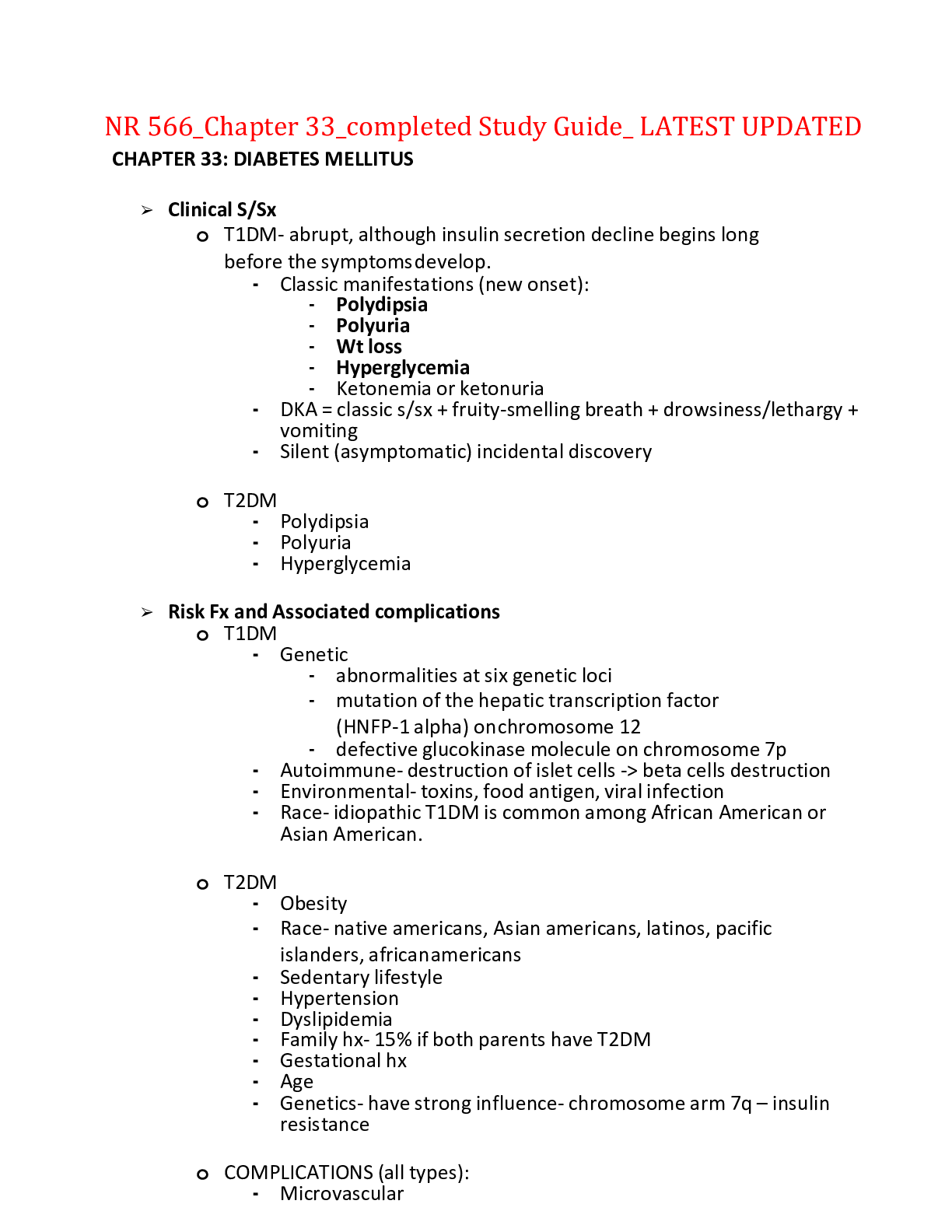
Buy this document to get the full access instantly
Instant Download Access after purchase
Buy NowInstant download
We Accept:

Reviews( 0 )
$14.00
Can't find what you want? Try our AI powered Search
Document information
Connected school, study & course
About the document
Uploaded On
Mar 06, 2022
Number of pages
21
Written in
All
Additional information
This document has been written for:
Uploaded
Mar 06, 2022
Downloads
0
Views
121

.png)



